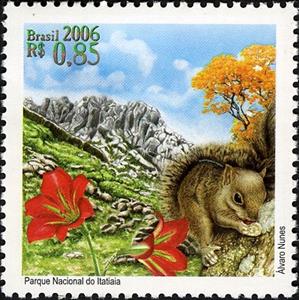Stamp: Ingram's Squirrel (Sciurus ingrami), (Tabebuia serratifolia) (Brazil 2006)
Ingram's Squirrel (Sciurus ingrami), (Tabebuia serratifolia) (Brazil 2006)
04 September (Brazil ) within release National Parks and Reserves goes into circulation Stamp Ingram's Squirrel (Sciurus ingrami), (Tabebuia serratifolia) face value 0.85 Brazilian real
| Stamp Ingram's Squirrel (Sciurus ingrami), (Tabebuia serratifolia) in catalogues | |
|---|---|
| Michel: | Mi:BR 3454 |
| Stamp Number: | Sn:BR 2991d |
| WADP Numbering System - WNS: | WAD:BR016.06 |
| RHM: | RHM:BR C-2656 |
Stamp is square format.
Itatiaia National ParkAlso in the issue National Parks and Reserves:
- Stamp - Bald Uakari (Cacajao calvus), Black Pacu (Colossoma macropom face value 0.85;
- Stamp - Maned Wolf (Chrysocyon brachyurus) face value 0.85;
- Stamp - Ingram's Squirrel (Sciurus ingrami), (Tabebuia serratifolia) face value 0.85;
- Stamp - Greater Rhea (Rhea americana), Kielmeyera rubriflora face value 0.85;
- Se-tenant - National Parks and Reserves face value 4*0.85;
Stamp Ingram's Squirrel (Sciurus ingrami), (Tabebuia serratifolia) it reflects the thematic directions:
A flower, sometimes known as a bloom or blossom, is the reproductive structure found in plants that are floral (plants of the division Magnoliophyta, also called angiosperms). The biological function of a flower is to effect reproduction, usually by providing a mechanism for the union of sperm with eggs. Flowers may facilitate outcrossing (fusion of sperm and eggs from different individuals in a population) or allow selfing (fusion of sperm and egg from the same flower). Some flowers produce diaspores without fertilization (parthenocarpy). Flowers contain sporangia and are the site where gametophytes develop. Many flowers have evolved to be attractive to animals, so as to cause them to be vectors for the transfer of pollen. After fertilization, the ovary of the flower develops into fruit containing seeds. In addition to facilitating the reproduction of flowering plants, flowers have long been admired and used by humans to beautify their environment, and also as objects of romance, ritual, religion, medicine and as a source of food.
Mammals are any vertebrates within the class Mammalia (/məˈmeɪli.ə/ from Latin mamma "breast"), a clade of endothermic amniotes distinguished from reptiles (including birds) by the possession of a neocortex (a region of the brain), hair, three middle ear bones and mammary glands. All female mammals nurse their young with milk, secreted from the mammary glands. Mammals include the largest animals on the planet, the great whales. The basic body type is a terrestrial quadruped, but some mammals are adapted for life at sea, in the air, in trees, underground or on two legs. The largest group of mammals, the placentals, have a placenta, which enables the feeding of the fetus during gestation. Mammals range in size from the 30–40 mm (1.2–1.6 in) bumblebee bat to the 30-meter (98 ft) blue whale. With the exception of the five species of monotreme (egg-laying mammals), all modern mammals give birth to live young. Most mammals, including the six most species-rich orders, belong to the placental group. The largest orders are the rodents, bats and Soricomorpha (shrews and allies). The next three biggest orders, depending on the biological classification scheme used, are the Primates (apes and monkeys), the Cetartiodactyla (whales and even-toed ungulates), and the Carnivora (cats, dogs, seals, and allies).
Flora is the plant life occurring in a particular region or time, generally the naturally occurring or indigenous—native plant life. The corresponding term for animal life is fauna. Flora, fauna and other forms of life such as fungi are collectively referred to as biota. Sometimes bacteria and fungi are also referred to as flora, as in the terms gut flora or skin flora.



